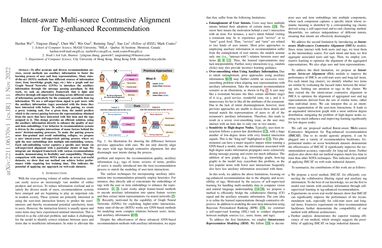Intent-aware Multi-source Contrastive Alignment for Tag-enhanced Recommendation
To offer accurate and diverse recommendation services, recent methods use auxiliary information to foster the learning process of user and item representations. Many SOTA methods fuse different sources of information (user, item, knowledge graph, tags, etc.) into a graph and use Graph Neural Networks to introduce the auxiliary information through the message passing paradigm. In this work, we seek an alternative framework that is light and effective through self-supervised learning across different sources of information, particularly for the commonly accessible item tag information. We use a self-supervision signal to pair users with the auxiliary information associated with the items they have interacted with before. To achieve the pairing, we create a proxy training task. For a given item, the model predicts the correct pairing between the representations obtained from the users that have interacted with this item and the assigned tags. This design provides an efficient solution, using the auxiliary information directly to enhance the quality of user and item embeddings. User behavior in recommendation systems is driven by the complex interactions of many factors behind the decision-making processes. To make the pairing process more fine-grained and avoid embedding collapse, we propose an intent-aware self-supervised pairing process where we split the user embeddings into multiple sub-embedding vectors. Each sub-embedding vector captures a specific user intent via self-supervised alignment with a particular cluster of tags. We integrate our designed framework with various recommendation models, demonstrating its flexibility and compatibility. Through comparison with numerous SOTA methods on seven real-world datasets, we show that our method can achieve better performance while requiring less training time. This indicates the potential of applying our approach on web-scale datasets.
PDF Abstract


